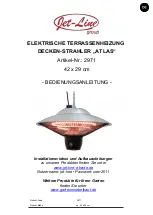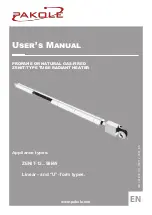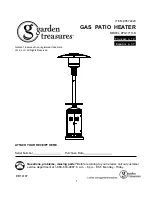
Working principle of the appliance
18
Instruction manual SGS
2
gis
appliance is under water supply pressure, cold water will automatically flow into
the tank. The valve remains open until the unsafe situation has been rectified.
The appliance is fitted standard with a connecting point for a T&P
valve
(3.7.2 "Hot water side")
.
2.5.4
Protection for the solar heating system
Drain-back tank
The solar heating system may optionally be equipped with a drain-back tank.
The tank fills itself with the heating fluid when there is no heat demand. This
avoids overheating of the solar heating system. The high insulation factor of the
tank also protects the system from freezing of the fluid. The use of the drain-
back tank also serves to extend the useful life of the fluid.
The presence of a drain-back tank is set
(12.8.1 "Setting the drain-back tank")
during the installation. Refer to the solar heating system manual for more
details.
Fluid temperature
The heat exchanger of the solar heating system may be filled with glycol. If the
temperature of the heating fluid is too high, a signal is sent to the controller of
the solar collector and the pump of the solar collector is switched off. This signal
is passed to the controller by temperature sensor S
1
.
At present, no heating fluids other than glycol are supported. The heating fluid
type is set
(12.8.2 "Setting the heating fluid type in the solar heating system")
during installation.
Temperature protection for solar heating system
2.5.5
Safety of the solar heating system
Expansion vessel
The solar heating system must be equipped with an expansion vessel (16). An
expansion vessel serves to limit pressure variations in the system. The
expansion vessel in the solar heating system can withstand a maximum
pressure of 6 bar. The supply pressure to the expansion vessel depends on the
static head of the system.
Besides the expansion vessel, the system is protected from overpressure by an
expansion valve
( "Expansion valve")
.
Expansion valve
The solar heating system is equipped with an expansion valve (23). The
expansion valve monitors the pressure in the solar heating system. If the
pressure is excessive (> 6 bar), then the valve will open. The hot water can now
flow out of the installation. The valve remains open until the unsafe situation has
passed, i.e. until the pressure has fallen back below 6 bar.
Note
Because the installation is always under pressure and is not automatically
filled, the system will again need to be replenished
(5 "Filling")
.
Protection
Description
Maximum temperature S
1
, if solar
heating system is filled with
glycol:
- S
1
> 130°C
The pump of the solar heating system
switches off when the temperature of the
heating fluid at S
1
exceeds the maximum
value. The solar heating system enters
error mode. The error is also visible on the
display of the SGS appliance
Summary of Contents for SGS - 100
Page 1: ...80 100 Installation User and Service Manual Installation User and Service Manual...
Page 2: ...www aosmithinternational com your installer...
Page 4: ...4 Instruction manual SGS gis...
Page 8: ...Table of contents 8 Instruction manual SGS...
Page 12: ...Introduction 12 Instruction manual SGS 1 gis...
Page 44: ...Installation 44 Instruction manual SGS 3 is...
Page 62: ...Shutting down 62 Instruction manual SGS 10 gis...
Page 92: ...Maintenance frequency 92 Instruction manual SGS 14 is...
Page 101: ...Instruction manual SGS 101 is...
Page 106: ...Appendices 106 Instruction manual SGS 17 is...
















































